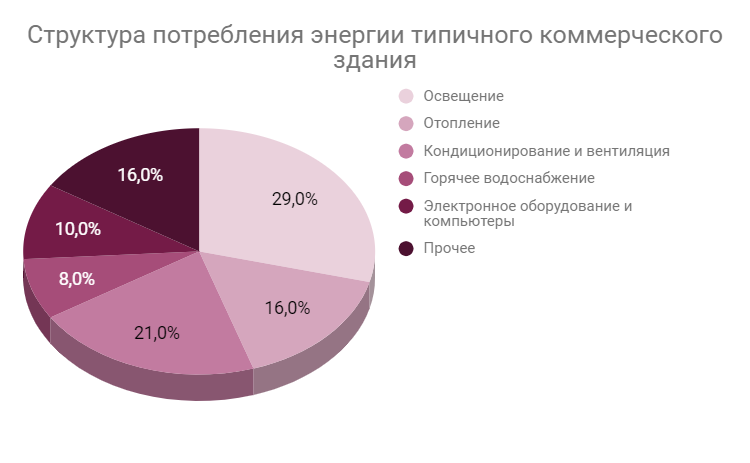


Energy Saving Technologies. Let`s understand, and analyze

2019-08-30
Energy saving is a new stage in technological development, as well as an absolute necessity with modern energy prices and tougher environmental standards.

In the structure of the operating costs of a typical commercial building, energy costs are about 30%, and in some enterprises of the metallurgical, chemical, oil refining industry, the share of energy in the cost of the product can reach 60%. Therefore, a correctly designed set of energy saving measures can significantly reduce costs and optimize the budget.
The main direction of development of world energy is the use of alternative renewable sources, such as solar, wind, water, biofuel energy. For Ukraine, it is also important to use waste from the agro-industrial complex, pellets, as well as to re-equip gas boilers.
To date, the share of renewable energy sources in the structure of energy production is 14.0%. At the same time, most remains for biofuels. At the same time, solar energy shows an average increase of 37.3% annually on average, wind energy (23.6%), biogas (12.3%). Indisputable leaders in the use of such energy are Scandinavian countries, where the share of alternative energy reaches 70%.
Scientists are constantly looking for new opportunities to improve efficiency and use of new cheaper materials for renewable energy sources. For example, not so long ago, scientists from China were able to increase the efficiency of organic solar cells, equating them to conventional ones. Modules made of carbon and plastic are much cheaper than conventional silicon ones, and thanks to their structure they can be applied to thin and flexible surfaces, to windows, facades, columns, trees, etc.
But do not forget that cheaper and ecological energy is good, but the energy efficiency inside the property is as important or maybe even greater.
According to the latest research by the University of Michigan, the structure of energy consumption in a commercial building is as follows:

Thus, 4 main systems of lighting, heating, air conditioning and ventilation as well as water supply account for 74% of total energy consumption. What technologies can be used to reduce this cost item?
Let’s start with heating. Experts say that the most heat flows through windows and walls, so the insulation of facades and the replacement of windows with energy-saving ones must have any commercial building. The next moment is the modernization of the heating system itself. Modern technologies allow modernizing existing boilers, and convert them from gas to organic fuels. Also, industry professionals recommend using the residual potential of process coolants. That is, the installation of recovery systems, steam traps, secondary use of hot water will help significantly improve the energy efficiency of the building. ‘
Lighting. Almost 20% of the world’s energy consumption comes from lighting. It has already become the norm, replacement of incandescent lamps with LEDs can show a saving of 5-7 times. Despite the relatively high cost compared to incandescent lamps, the life of such lighting elements is 7-10 times longer. Of the shortcomings of LED lighting, the largest is the content of mercury, which means that you need to take care of the proper disposal of light bulbs in advance.
The next stage in reducing lighting costs can be the installation of light sensors, motion and maximum use of daylight. Thanks to the use of various sensors, you can automatically adjust the brightness of the lighting, turn off the light when people leave the room. In some cases this can save another 20%.
Air conditioning and ventilation. The most common method of reducing costs when using this equipment is the installation of recovery systems. Proper setup and timely maintenance can reduce costs by up to 10%. Of course, such systems are best to design in the construction, but it is not uncommon for modernizations to be carried out in buildings that have been built for a long time already, and it is important to turn to experienced projectors that will help correctly calculate all the indicators and install the system in the most optimal way.
Water supply. One of the popular technologies for saving water is collecting and subsequent processing of rainwater for later use in the building. Of course, it is only relevant in latitudes, where rains happen quite often, and in winter there is no sub-zero temperature. For most developed countries, automated water flow sensors are relevant, using the residual potential of heat carriers to heat water.
All of the above methods and technologies can be used both separately and in a complex. Here, an individual approach is important, a preliminary study of all the features of the facility, infrastructure and systems, an energy audit to identify the most vulnerable places. In the face of complex economic realities, a complete conversion of the building to an energy-efficient solution is hardly possible, but with the developed plan, a gradual decrease in costs will positively affect both the cost of production and the productivity of the work.

 FACILITY
FACILITY 